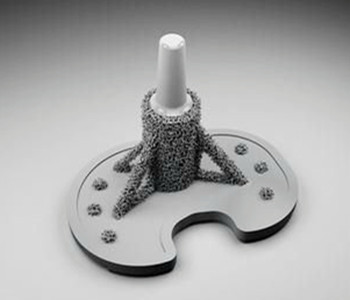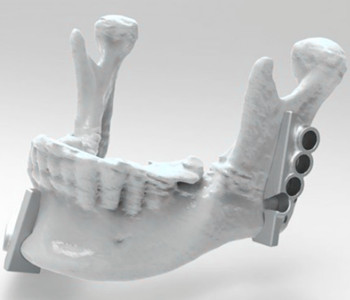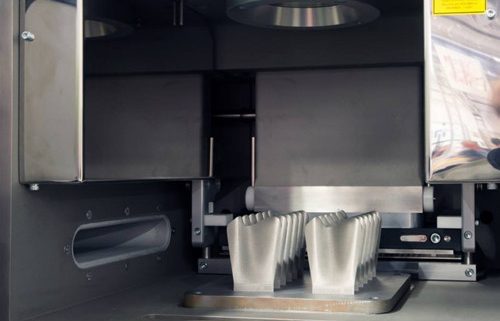Brief introduction of widely used metal materials for 3D printing
3D metal printing, also commonly known as metal fusion, has conquered new markets in aeronautics, medical, construction and automotive sectors in last few years with its incomparable advantages and convenience. At present, 3D printing metal technology is fast and relatively cheap, can also be used to create large structures. The printing technology mainly includes selective laser sintering (SLS), electron beam fusion (EBM), selective laser fusion (SLM) and laser engineered net shaping (LENS). SLM use a high-energy laser source which can melt a variety of metal powder, is the most commonly used method. Metal powder used for 3D printers in domestic and foreign generally are: Tool steel, Martensitic steel, Stainless steel, Pure titanium and titanium alloy, Aluminum alloy, Nickel base alloy, Copper base alloy, Cobalt-chromium alloy and so on.
STAINLESS STEEL
 Stainless steel is the first material used in 3D metal printing due to its good chemical resistance, high-temperature resistance and good mechanical properties. At present, there are mainly three kinds of stainless steel applied in metal 3D printing: Austenite stainless steel 316L, Martensite stainless steel 15-5PH and Martensite stainless steel 17-4PH.
Stainless steel is the first material used in 3D metal printing due to its good chemical resistance, high-temperature resistance and good mechanical properties. At present, there are mainly three kinds of stainless steel applied in metal 3D printing: Austenite stainless steel 316L, Martensite stainless steel 15-5PH and Martensite stainless steel 17-4PH.
316L Austenitic stainless steel, with high strength and corrosion resistance, can be reduced to low temperature in a wide range of temperatures. It is applied in various engineering applications such as aerospace and petrochemical, as well as food processing and medical treatment.
15-5PH Martensitic stainless steel, also known as Martensitic aging (precipitated hardening) stainless steel, has high strength, good toughness and corrosion resistance, is a further hardening of the ferrite-free steel. At present, it is widely used in aerospace, petrochemical, chemical, food processing, paper and metal processing industries.
17-4 PH Martensitic stainless steel, which still has high strength and high toughness under 315 ℃, and strong resistance to corrosion and can bring excellent ductility as the laser machining state.
TITANIUM ALLOY
 Titanium alloys have been widely used in aerospace, chemical industry, nuclear industry, sports equipment and medical devices due to their high temperature resistance, high corrosion resistance, high strength, low density and biocompatibility. Titanium alloy parts have been widely used in high-tech fields, such as F14, F15, F117, B2 and F22 military aircraft. The proportion of titanium used in a Boeing 747 aircraft is respectively 24%, 27%, 25%, 26% and 42%. However, the traditional forging and casting methods to produce large titanium alloy parts have many disadvantages, such as high cost, complex process, low material utilization rate and difficult follow-up processing, which hinder its wider application. Metal 3D printing technology can solve these problems fundamentally, so it has become a new technology for directly manufacturing titanium alloy parts in recent years.
Titanium alloys have been widely used in aerospace, chemical industry, nuclear industry, sports equipment and medical devices due to their high temperature resistance, high corrosion resistance, high strength, low density and biocompatibility. Titanium alloy parts have been widely used in high-tech fields, such as F14, F15, F117, B2 and F22 military aircraft. The proportion of titanium used in a Boeing 747 aircraft is respectively 24%, 27%, 25%, 26% and 42%. However, the traditional forging and casting methods to produce large titanium alloy parts have many disadvantages, such as high cost, complex process, low material utilization rate and difficult follow-up processing, which hinder its wider application. Metal 3D printing technology can solve these problems fundamentally, so it has become a new technology for directly manufacturing titanium alloy parts in recent years.
TiAl6V4 (Gr5) is the first alloy used in SLM3D printing production. However, the poor plastic shear deformation resistance and wear resistance of titanium limit its use under high temperature, corrosion and wear resistance conditions. Therefore, Re and Ni are introduced into titanium alloys, and the 3D printed Re-based composite sprinkler has been successfully applied to the combustion chamber of aero-engine, and the operating temperature can reach 2200%.
COBALT
H13 hot work tool steel is one of them. Tool steels are widely used in industrial parts because of their excellent hardness, wear resistance, deformation resistance and the ability to maintain cutting edges at high temperatures. Martensitic steels, taking Martensite 300 as an example, also known as maraging steels, are noted for their high strength, toughness and dimensional stability during aging. Due to its high hardness and wear resistance, Martensite 300 is suitable for many die applications such as injection molds, light metal alloy casting, stamping and extrusion, and is also widely used in aerospace, high strength fuselage parts and racing car parts.
ALUMINUM ALLOY
Aluminum alloys have excellent physical, chemical and mechanical properties and have been widely used in many fields. However, the properties of aluminum alloys themselves (such as easy oxidation, high reflection and thermal conductivity) increase the difficulty of selective laser fusion manufacturing. There are some problems such as oxidation, residual stress, void defects and densification in SLM process when printing aluminum alloys. These problems can be improved by strictly protecting atmosphere, increasing laser power and reducing sweep speed. At present, SLM prints aluminum alloy materials mainly are the Al-Si-Mg series alloy such as AlSi12 and AlSi10Mg. Aluminum-silicon 12 is a lightweight additive manufacturing metal powder with good thermal performance. It can be applied to thin wall parts, such as heat exchangers or other auto parts. It can also be applied to the prototype and production parts of aerospace and aviation industry.The addition of silicon and magnesium gives the aluminum alloy more strength and hardness, making it suitable for thin wall and complex geometric parts, especially in the case of good thermal performance and low weight.
MAGNESIUM ALLOY
As the lightest structural alloy, magnesium alloy has the possibility of replacing steel and aluminum alloy in many application fields due to its special high strength and damping properties. For example, lightweight applications of magnesium alloys in automotive and aircraft components can reduce fuel use and exhaust emissions. Mg alloy has excellent in-situ degradation and biocompatibility, with low Young’s modulus and close to the human bone strength. It has more application prospect in surgical implantation than traditional alloy.
HIGH-TEMPERATURE ALLOY
 High temperature alloy refers to the super steel alloy which with iron, nickel and cobalt as the base and can still long-term work in the high temperature of 600 ℃ or above and stress environment. It has high temperature strength, good resistance to corrosion resistance and oxidation resistance and good plasticity and toughness. At present, the alloys can be roughly divided into three categories: Fe based alloy, nickel based alloy and cobalt alloy.
High temperature alloy refers to the super steel alloy which with iron, nickel and cobalt as the base and can still long-term work in the high temperature of 600 ℃ or above and stress environment. It has high temperature strength, good resistance to corrosion resistance and oxidation resistance and good plasticity and toughness. At present, the alloys can be roughly divided into three categories: Fe based alloy, nickel based alloy and cobalt alloy.
Superalloy is mainly used in high-performance engines. In modern advanced aero engines, the use of superalloy material accounts for 40% ~ 60% of the total engine mass. The development of modern high performance aero engines requires more and more high temperature and performance of superalloy. The traditional metallurgical process of ingots is slow in cooling, some elements and second phase segregation are serious in ingots. 3D printing is a new method to solve the technical bottleneck in nickel alloy forming.
As a result, Inconel 625 is frequently used in metal parts used in marine applications and oil and gas production. Inconel 718 is an age-hardened version of 625. 718 is a nickel-based alloy, which has good corrosion resistance and heat resistance, stretching, fatigue and creep properties, and is suitable for various high-end applications, such as aircraft turbine engines and land-based turbines. Inconel 718 alloy is the earliest used nickel base superalloy and is also the most used alloy of the aero engine at present.
Cobalt-chromium alloy has high strength, strong corrosion resistance, good biocompatibility and non-magnetic properties. It is mainly used in surgical implants, including alloy artificial joints, knee joints and hip joints, and can also be used in engine parts, fashion and jewelry industries.
Since the emergence of 3D printing technology in the 1990s, from the initial polymer materials to metal powder, many new technologies, new equipment and new materials have been developed and applied. There are a wide range of metal materials suitable for industrial 3D printing, but only several specified powder materials can meet the requirements of industrial production. Although the 3D printing technology of metal powder has achieved some achievements at present, the material is still the biggest factor and there are more higher requirements on 3D printing materials. Therefore, the development of 3D printing technology of metal powder still has a long way to go.



